The Best Laptops Of 2022
From Ultrabooks like the Dell XPS 13 to large-screen marvels like the LG Gram 17, top-tier laptops released in the year 2022 arrived in a variety of sizes and weights. While several manufacturers are actively working to make their products lighter and more portable, weighty laptop enthusiasts can still find a gaming PC that meets their expectations on the market. Moreover, several companies have been experimenting with laptop concept designs like the dual-screen laptop, as is seen on the ASUS Zenbook Pro 14 Duo. And it's not just the exterior design bunch: even chip manufacturers, like Intel and now Apple, are doing their part to keep processing power at pace with memory, storage, and other hardware components.
Whether it's for professional purposes or creative work, users will find that there's a high-quality laptop available to service every need. This article discusses some of the best laptops of 2022, their specifications, special features, and why they're this year's big winners.
M2 MacBook Pro
Apple needs no introduction in the PC space at this stage of the company's journey. Apple's MacBook Pro is one of the most iconic laptops on offer, and this year's edition, the 2022 M2 MacBook Pro 13, lives up to the hype. The major highlight of Apple's latest laptops is the ARM-based chip manufactured by Apple itself.
An upgrade from the M1 chip, the Apple M2 chip on the similarly-named M2 MacBook Pro reinforces Apple's identity as a creator of its own laptop chipsets. The M2 chip consists of an octa-core CPU, a 16-core neural engine, and a 10-core GPU, making it up to 1.4 times faster than the M1 chip. With more command over the internal technology, Apple has worked to improve the overall outlook of the M2 MacBook Pro — especially in such areas as security, memory, and customization.
Alongside the new chipset, the 2022 M2 MacBook Pro also sports an assembly of premium components and features. It houses a 58.2 Watt-hour (Wh) LiPo battery, which is juiced up by a 67 Watt (W) USB-C charging brick. The RAM and internal solid-state drive (SSD) storage start at 8 GB and 256 GB respectively, and they can be maxed up to 24 GB of RAM and 2 TB of internal storage. Its 720p HD camera is supported with advanced computation and image processing, enabling the MacBook to take some of the best shots and videos possible on a laptop today. And for all of these specs and more, the M2 MacBook Pro weighs in at just about three pounds.
Dell XPS 13
Enter the Dell XPS 13 2022, Dell's annual refresh of the 13-inch ultrabook lineup. Among the several laptop models that run on the Windows operating system, Dell PCs are highly reputed for their top quality. And this year's XPS 13 is proof that Dell has not let up on its promise to always deliver PCs ranking among the best. The XPS 13 runs on a 12th-Gen Intel Core i5 processor, features a 13.4-inch Full HD+ display, houses a 51 Wh triple-cell battery charged with a 45 W USB-C adapter, and records media with a 720p HD camera. With 8 GB of RAM, 512 GB of SSD storage, and an Intel Iris Xe graphics card, there's no doubt about the processing power of this device for various apps and games.
But this year, Dell didn't stop at the XPS 13. The company also delivered a Dell XPS 13 Plus, which has sparked some debate based on its design, utility, and... existence. The XPS 13 Plus sports a simple but refreshing design, stretching the keyboard to both edges of the PC. In addition, it upgrades several features from the base-level XPS 13, including a larger 55 Wh battery, a 60 W USB-C AC adapter, and a Gen 4 PCIe solid-state storage drive. With a starting weight of 2.71 pounds, the XPS 13 Plus is also heavier than the 13. Other specifications found in both PCs include a backlit keyboard with a fingerprint reader, impressive thermal design, and double stereo speakers allowing for remarkable sound quality.
HP Spectre x360
HP is without a doubt Dell's most visible rival in the PC industry. Both companies compete for laptop supremacy year-on-year, and they are household names among users. Thus, it's no surprise that HP would ship its own premium laptop, the HP Spectre x360, to match — or outperform — the Dell XPS 13. The HP Spectre x360 is a 2-in-1 laptop, coming in 13.5-inch and 16-inch variants in 2022. The more recent 13.5-inch ultrabook ships with a 1280p display, an Intel Core i5 processor, 8 GB of RAM, and 512 GB of SSD storage. For its enhanced version, HP has stuck with a 2000p display, an Intel Core i7 processor, 16 GB of RAM expandable to 32 GB, and 1 TB of storage. Both versions are Intel Evo certified, meaning that users know they're premium even before buying. In addition, the 13.5-inch x360 offers up to 16 hours of battery life on normal use.
As a dual-purpose PC, the x360 reflects HP's attention to design details. The company has managed to fit these specs into a 3-lb. laptop, and its lightweight nature makes it comfortable to use as a tablet. Users who prefer a bigger screen would love the 16-inch model, which has similar internal specifications with a larger screen and battery. Also, the Spectre x360 supports HP's MPP 2.0 stylus. Given that HP has continued to innovate with Spectre laptops, the x360 might as well be a segue into the company's next steps as a PC maker.
MacBook Air M2
Strangely enough, but to the delight of some consumers, the lines between the MacBook Pro and MacBook Air are rapidly blurring. Apple has historically released both laptops for different market classes, with the MacBook Pro known to be superior to the MacBook Air in every spec category. Now the MacBook Air doesn't just look and feel like the MacBook Pro; it also runs like the MacBook Pro. The company's decision to not only revamp the MacBook Air's design but also use the M2 chip has been met with admiration, but how this will affect Apple's laptop sales trends in the long term is yet to be determined.
Of course, the M2 MacBook Air still maintains certain differences, though minor, from the M2 MacBook Pro. For one, the Air's M2 chip starts with an octa-core GPU, which can then be configured to a 10-core GPU like the Pro. Other features of the MacBook Air include a 52.6 Wh lithium-polymer battery charged with a 30 W or 35 W adapter, a 13.6-inch, 1664p 224 PPI liquid retina display, a 1080p HD camera housed in a top-central display notch, a main Magsafe 3 charging port with two Thunderbolt ports that support charging, a touch ID sensor, and a backlit keyboard. At a weight of 2.7 pounds, the MacBook Air is a great choice for several use cases, and its market has widened due to these spec upgrades.
Dell XPS 17
For people who love big screens — which, as it turns out, is a lot of people — the Dell XPS 17 is a go-to laptop computer. The elder sibling to the XPS 13, the Dell XPS 17 sits at the pinnacle of Dell's XPS lineup. At its basic level, the laptop features a 17-inch 1200p anti-glare display, a 12th-Gen Intel Core i5 chip, a 97 Wh 6-cell battery pack, a 720p HD camera, 512 GB of SSD internal storage, and 8 GB or 16 GB of RAM. At its highest level, the XPS 17 transcends from a PC into another category of machine. A 12th-Gen Intel Core i9 processor, 64 GB of RAM, 8 TB of storage, a 2400p display, and an NVIDIA GeForce 6 GB 60 W graphics card all converge to create a laptop that would be overkill for the average PC user but dreamlike for enthusiasts and creators.
With PCs like the Dell XPS 17, it's less about annual refreshes and more about specification upgrades. The laptops are released in a continuum, in accordance with the latest features and technology. And as one might expect, this commitment to the frontier of laptop technology — in addition to its already huge screen size — makes the Dell XPS 17 one of the most expensive laptops in the market. Starting at $1,949 with basic features, it can cost close to $5,000 when the specs are all maxed out. But for this powerhouse of a PC, the price is absolutely worth it. At least that's what laptop geeks think.
ASUS ROG Zephyrus G15
It's 2022, and no list of the best laptops can be complete without mentioning that of the gaming niche. Gaming PCs are some of the most feature-stacked gadgets overall, but even among these PCs, few stand out like the ASUS ROG Zephyrus G15. ASUS found a window of opportunity in non-console gaming, first with their ROG gaming phones and then with the ROG laptops. And the company is not looking back, as it has made strides — and made money — with this fan-favorite lineup.
The ROG Zephyrus G15 features an AMD Ryzen 7 Mobile Processor with 4.7 gigahertz (GHz) max frequency, paired with the NVIDIA GeForce RTX 3060 graphics card. With a 15.6-inch 1440p display, the G15 promises an immersive and lag-free experience for gamers. Other specs include a double 8 GB RAM setup totaling 16 GB, an internal storage space of 1 TB on the SSD, a 720p HD infrared camera that supports Windows Hello authentication, and improved thermals for rapid cooling. At just above four pounds of weight, users would find that it's not a pain to carry around.
To further boost the experience, ASUS provides a slew of accessories that can be used with the ROG Zephyrus G15. These include the ASUS Pen, the ASUS Marshmallow Mouse, the ASUS Active Stylus, a universal adapter for charging, a multi-device gaming mouse, and of course, a carry bag for the PC. With the ROG Zephyrus G15 already starting at close to $3,000, including these accessories would surely take the price up a notch.
Microsoft Surface Pro 9
As the custodian of Windows OS, Microsoft is largely expected to deliver the best Windows software features with its laptops. The company has worked to do just that with its Surface Pro lineup, and this year, Microsoft has pushed the experience even further. One of the best products in the 2-in-1 laptop market, the Surface Pro 9 doubles as a laptop and a tablet. It is designed for professionals and creators who need a potent but ultraportable daily driver for work, but users will find that it is capable of much more.
The Surface Pro 9 sports a 13-inch, 1920p 267 PPI display, a 12th-Gen Intel Core i5 or i7 processor, a 1080p camera setup, stylus pen compatibility with the Surface Slim Pen 2, and up to 15.5 hours of typical battery life offered by a 47.7 Wh battery. Starting at 8 GB of RAM and 128 GB of storage in an SSD, both can be expanded up to 32 GB of RAM and 1 TB of storage. And at 1.94 pounds, the Surface Pro 9 is one of the lightest PCs on offer.
Microsoft has also gone further by releasing a 5G-supportive version of the Surface. The distinctions between the Surface Pro 9 with 5G from the base-level Surface Pro 9 include its Microsoft SQ 3 processor, a neural processing unit, and a Microsoft SQ 3 Adreno 8CX Gen 3 graphics card. Both devices are compatible with Surface keyboards, use Windows Hello for authentication, and have their SSDs removable.
LG Gram 17
LG, originally known for its electrical and electronic appliances, has made a name for itself in the PC market by masterfully implementing a simple strategy: lightweight laptops. The company's track record in light PCs is already extensive within a relatively short period, and in fact, LG holds a Guinness World Record for the lightest 16-inch laptop in the world which is its LG Gram 16. With the LG Gram 17, the ultra-slim, ultra-lightweight laptop niche solidifies itself as one to be taken seriously.
To start with, the LG Gram 17 weighs less than three pounds. Within this minimal weight rests a 12th-Gen Intel Core i7 processor, an Intel Iris XE graphics card, 16 GB of RAM, and 1 TB of storage. The 17-inch laptop display has a 1600p resolution and a 16:10 aspect ratio with rich colors. And the entire machine is powered by an 80 Wh lithium-ion battery, which comes with a 65 W USB-C charger. Fitting all of these high-end specifications into such a slim laptop is a commendable feat of hardware engineering by LG.
With the success of the LG Gram 16 and Gram 17, one is left to wonder where the company is headed with PCs. The previously released LG Gram 2-in-1 conveyed LG's interest in the dual-purpose laptop space, and the brand may not be looking back from there. It's worth watching how the Gram PC lineup will evolve, even as LG works its way to the top of the fiercely competitive PC market through ultra-lightweight tech.
ASUS Zenbook Pro 14 Duo
The smartphone industry has seen the rise of foldables and flip phones as new dimensions of smartphones. Now, even laptops are getting more... experimental. And ASUS thinks it has the perfect idea for how to best utilize the unused space close to a laptop's keyboard and trackpad. The idea? Slap a screen on it, so the laptop has two separate screens for multiple purposes. And thus, from previously being a mere concept design, the dual-screen laptop has entered the mainstream PC market, mainly due to the efforts of ASUS and its Pro Duo lineup.
The ASUS Zenbook Pro 14 Duo is an unusual but well-thought-out product. It's the world's first 14.5-inch laptop with a 1800p 120 Hz touch display, and this also applies to the secondary screen, tagged the ScreenPad Plus. The Intel Evo-certified PC features an Intel Core i9 processor, an NVIDIA GeForce RTX 3050 Ti graphics card, a 76 Wh battery, up to 32 GB of RAM, and up to 2 TB of storage with an SSD. With a keyboard engineered to precision, an HD camera, and artificial intelligence-based noise cancellation for audio, the Zenbook Pro 14 Duo is nothing short of a steal for its target audience.
This laptop is designed and built for creators and professionals who would prefer to work with multiple screens on the same device. However, the use cases for a dual-screen laptop keep increasing, and we might soon witness it become a favorite for people of other industries and with other needs.
Lenovo ThinkPad X1 Yoga
A major difference between today's PC market and that of the past is that laptop manufacturers are intentionally considering specific use cases and building PCs in accord. Take the Lenovo ThinkPad X1 laptops, for instance, which are made with business people in mind. Lenovo has sought to meet professional needs with its ThinkPad X1 Yoga series, and the 2022-released Lenovo ThinkPad X1 Yoga Gen 7 exemplifies how far the company has come with this vision.
Of course, the Lenovo ThinkPad X1 Yoga Gen 7 does not sacrifice premium features for anything. This 2-in-1 convertible PC runs on the 12th Gen Intel Core i7 processor, which comes with an Intel Iris Xe graphics card for smooth usage. It's powered by a 57Wh battery that supports fast charging through a 65W Rapid Charge brick. Its memory specs are also high-level, with 16GB of RAM and 512GB of SSD storage. And for security, the ThinkPad pairs a facial recognition camera with a fingerprint sensor that powers the PC on when touched.
At a considerably light 3.04 pounds, the 14-inch 1200p display laptop works perfectly for its target consumers. It's easy to carry around and even easier to use, especially since it ships with the Lenovo Integrated stylus pen. Outside its audience, students who can afford the ThinkPad X1 Yoga Gen 7 — which goes for close to $1.600 and can increase beyond $2,000 based on spec choices — might also find this a great back-to-school PC for note-taking in classes and flexible academic work.
Acer Swift 5
If laptops were ranked on design and build alone, the Acer Swift 5 might just find itself at the number one spot. This computer is housed in an aerospace-grade chassis made of aluminum and machined to high standards. Pairing this with a well-calculated interior design and finish, it's no surprise that the Acer Swift 5 was awarded an IF Design Award in 2022. The laptop's exterior is itself a major selling point.
The Swift 5 works with a 1600p colorful display with a 92.22% screen-to-body ratio. Inside you'll find an Intel Core i7 processor, Intel Iris Xe graphics, 16GB LPDDR5 RAM, and up to 1TB of internal storage. This machine ships with Windows 11 OS pre-installed. This is just the latest in a line of Acer Swift devices that have been released over the past several years. Based on what we've seen in our own reviews of the lineup, there's little reason to doubt that Acer will continue to stay on point through the future.











